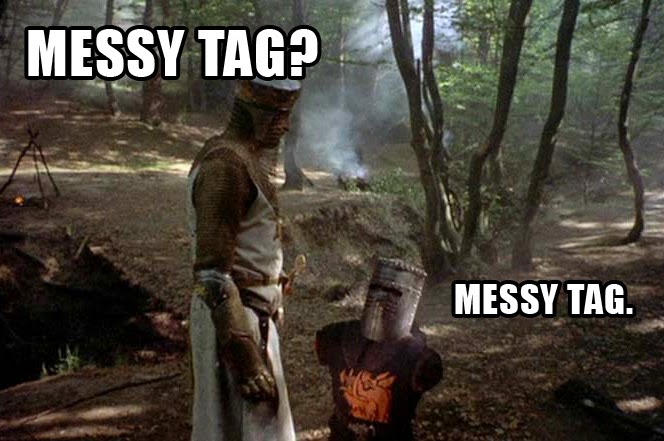
The “Messy” tag scares (and inspires) me
I’ve run 5 games, for various people each time (introducing a lot of people to the game) so I have yet to put players up against anything tough. I love the idea of monsters tearing the limbs of characters off but it has me wondering… what happens after a few sessions of facing such creatures?
I keep imagining walking down the street of a town full of former adventurers, all of them missing at least one limb, or perhaps the Holy Grail knight with all of his “flesh wounds” (see image I made, attached).
What happens to characters after losing a limb or three in your game? Have there been cases in your games where multiple PC’s lost limbs in one fight? Do you work in recovery of them or does it become a new tag they must contend with, like “clumsy” until, perhaps, they get used to it?

Tim Franzke This is the question I was going to hit you up earlier with via hangouts (in case you wonder what that message was going to be about).
So, usually when a monster has a messy tag, this is a sign that you can’t D&D it. Namely toe-to-toe-ing is unlikely to end well. Smart PCs come up with traps, and other ways of dealing with the critter (balistae, falling stalactites etc.)
But when the inevitable loss of limb happens, PCs do what PCs always do. They find a solution.
One of my favorites was the lady that lost her arm and eye to a dragon. She multi-classed into paladin and when she would have a giant glowing eye and arm as the mark of her god.
Come up with solutions. Some get golden limbs made by dwarves. Wizards might be able to ritual up arms at a cost. So on.
What Stras said, but only if they actually survive.
Time for some brainstorming.
There is more than just losing limbs: losing an eye, getting an ear mangled, broken bones (esp compound fractures), jagged wounds that leave livid scars, disembowelment, sprains, blood blood everywhere (slippy!), scalping, third degree burns, puncture wounds that go all the way through and come out the back, bites take out of soft flesh, getting fish-hooked, having a limb temporarily disabled (but not totally removed). Also you can remove a limb many times.. there are five fingers, then a hand, then a forearm, and finally the whole arm. Some spells or unguents may allow re-attaching severed members. Then there are regeneration effects and wishes (which I think should be rarer… I like the idea of a fighter carrying around his slowly rotting hand, hoping to find a healer who can reattach it). And of course minor things like getting fingernails ripped off (OUCH), nose or ears mutilated, eyes punctured (I knew I guy who recovered normally from this but had a blind swollen eye for a long time first), non-fatal spikes through your skull, teeth knocked out, cheeks pierced (hello drooly!). Not to mention monsters like botflies or alien facehuggers or flesh eating bacteria… definitely messy and disgusting, but not automatically fatal. Some D&D monsters are messy too: mind flayers come to mind.
But yeah, you can’t just D&D with it. Well okay you can, but it’s not going to D&D with you…
So, in the game I’m currently playing, the hold of our airship is filled with a whole crate full of clockwork prosthetic limbs.
(Also some clockwork prosthetic tongues… Oh, yeah, and a giant robot scorpion that’s been cobbled together out of clockwork limbs.)
Peter Goderie Do you know if this was a convenient (non-coincidental) aspect of your game put in place by the DM to dampen the blow of future lost limbs, or is this just coincidence?
Well, at first we were all like, “yay, we found a cache of prosthetic clockwork limbs! Let’s sell them on the black market!” But then one of the PCs lost a hand last session. Actually, come to think of it, another PC lost a hand the session before that.
Uh-oh.
So those will come in… handy then? hehe :p
11 days later, I’m realizing I forgot to thank Mike Harvey for that brainstorming there, in looking over this again – it did a lot to help me see the possibilities. There were things in there I have used as part of my descriptions of gnarly hits, but your list made me realize I was really narrowing the scope. Thanks for the eye-opener